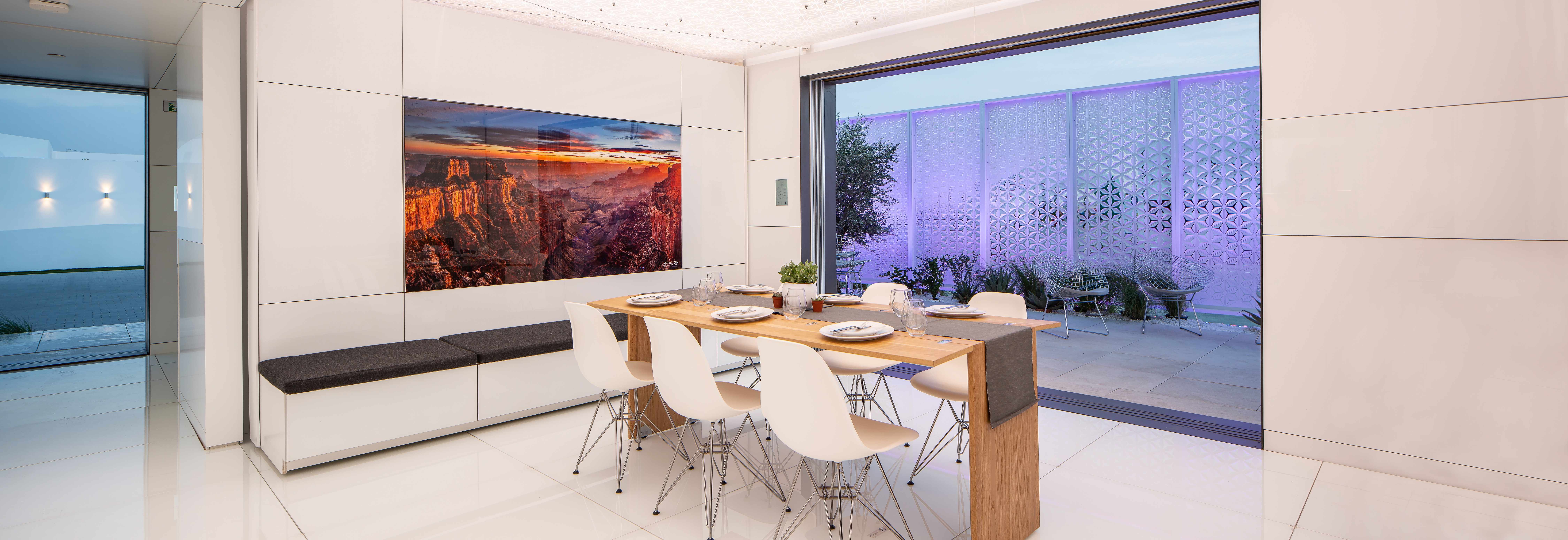FutureHAUS Dubai: Your next house
May 20, 2019

Last summer, a neighborhood of the future sprang up on a strip of Dubai desert. It was the site of the 2018 Solar Decathlon Middle East competition, which included one small solar home that produced more energy than it used overall.
That house was designed and built by the FutureHAUS Dubai team, an interdisciplinary collaboration that involved students and researchers from Virginia Tech’s College of Architecture and Urban Studies who led the project, College of Engineering, Myers-Lawson School of Construction, Pamplin College of Business, College of Liberal Arts and Human Sciences, and College of Science. “We won!” said Igor Cvetkovic, technical director of the Center for Power Electronics (CPES) and the power electronics lead on the project.
“This project demonstrated how, if we trust each other and work together, interdisciplinary teams can achieve incredible things,” said Cvetkovic. “We created something completely new that ended up being the best of its kind in the world.”
The competition was the result of a joint effort by the United States Department of Energy and the United Arab Emirates’ Dubai Electricity & Water Authority. Of the 15 international university teams competing, Virginia Tech was the only one based in the United States.
Virginia Tech’s win follows almost two decades of research, two years of focused design and development, and more than a month in Dubai—where two dozen students and faculty members erected, tested, debugged, adjusted, and perfected their solar house.
Practicing new power perspectives
Cvetkovic, three ECE undergraduate students—Matt Erwin (CPE senior), Elif Patton (EE senior), Michaela Goldammer (EE senior)—and four CPES graduate students—Vladimir Mitrovic, Joshua Stewart, Hao Xue, and Sarah El-Helw—worked closely with team members from the School of Architecture + Design. Together they interlaced FutureHAUS Dubai with a state-of-the-art electronics infrastructure that demonstrated the transformative capabilities of advanced power electronics in the home.
The FutureHAUS power infrastructure included 14-kilowatt solar arrays and a 14-kilowatt-hour energy storage system. The solar array and batteries fed excess energy into the grid via an 8-kilowatt bidirectional power inverter.
For safety reasons, all teams used standard power electronics technology—converters, batteries, chargers, and solar panels. But the Virginia Tech team had their own spin on implementation; they designed a system that used commercial technology in unconventional ways.
“We disabled standard modes of operation in the equipment we used and implemented our own controls—that’s how we went beyond other teams,” explained Cvetkovic. “The competition rules did not allow for the use of power electronics prototypes and, although that would have been an ideal fit for CPES, we still pushed boundaries further than anyone else.”
FutureHAUS challenged the building industry by demonstrating the use of advanced manufacturing concepts, prefabricated structures, and modular-cartridge design to redefine conventional practices of modern energy-efficient building with plug-and-play capability.
“You could literally snap house cartridges together like LEGO® blocks, and have a home put together in a few hours, with all electrical, mechanical, and plumbing infrastructure interconnected,” said Cvetkovic. “You would just step inside and enjoy.”
DC-powered wall
FutureHAUS is a 900-square-foot house, and the Virginia Tech team looked beyond their immediate goals by engineering some elbow room. They installed a moving wall powered by direct current (dc) that transformed one room into two.
The wall, which moved along a hidden rail, was outfitted with an entertainment system. By using dc to power it, the team was able to seamlessly and efficiently deliver low voltage to what they called “flex space.”
“Moving toward dc for domestic applications is slowly becoming an industry-wide trend, and we were able to show how this form of power distribution can be safely implemented in a home and work great,” said Cvetkovic. “This was innovation executed safely.”
The Solar Decathlon committee evidently appreciated the demonstration. In addition to winning first place overall, the team made a strong showing in the subcontests: first place in architecture, first place in creative solutions, second place in energy efficiency, second place in interior design, third place in sustainability, and third place in engineering and construction.
But the work didn’t stop with the competition. CPES researchers have continued to improve upon and expand the power electronics technology on brilliant display in FutureHAUS Dubai.
“It was an amazing and very gratifying experience, and that’s what university is about. Opening new doors and learning from each other in a great interdisciplinary atmosphere,” said Cvetkovic. “But stay tuned. There’s more coming.”


